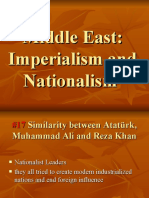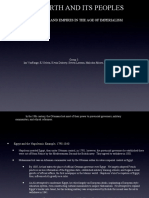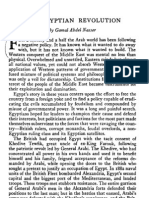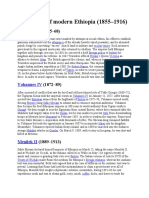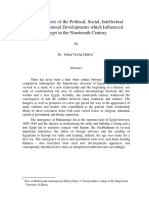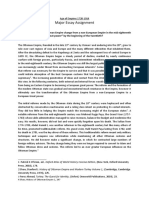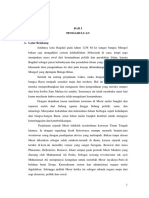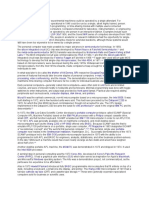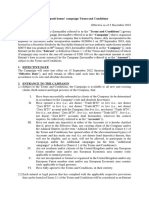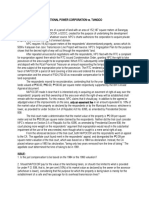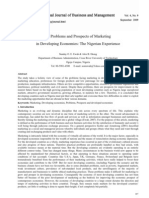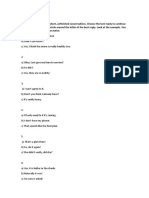Early Modern: Ottoman Egypt (1517-1867) : Ottoman Turks Ottoman Empire
Early Modern: Ottoman Egypt (1517-1867) : Ottoman Turks Ottoman Empire
Uploaded by
sajmirCopyright:
Available Formats
Early Modern: Ottoman Egypt (1517-1867) : Ottoman Turks Ottoman Empire
Early Modern: Ottoman Egypt (1517-1867) : Ottoman Turks Ottoman Empire
Uploaded by
sajmirOriginal Description:
Original Title
Copyright
Available Formats
Share this document
Did you find this document useful?
Is this content inappropriate?
Copyright:
Available Formats
Early Modern: Ottoman Egypt (1517-1867) : Ottoman Turks Ottoman Empire
Early Modern: Ottoman Egypt (1517-1867) : Ottoman Turks Ottoman Empire
Uploaded by
sajmirCopyright:
Available Formats
Early modern: Ottoman Egypt (1517–1867)
Main article: Egypt Eyalet
Egypt was conquered by the Ottoman Turks in 1517, after which it became a province of
the Ottoman Empire. The defensive militarisation damaged its civil society and economic institutions.
[38]
The weakening of the economic system combined with the effects of plague left Egypt vulnerable
to foreign invasion. Portuguese traders took over their trade. [38] Between 1687 and 1731, Egypt
experienced six famines.[40] The 1784 famine cost it roughly one-sixth of its population. [41]
Egypt was always a difficult province for the Ottoman Sultans to control, due in part to the continuing
power and influence of the Mamluks, the Egyptian military caste who had ruled the country for
centuries.
Napoleon defeated the Mamluk troops in the Battle of the Pyramids, 21 July 1798, painted by Lejeune.
Egypt remained semi-autonomous under the Mamluks until it was invaded by the French forces
of Napoleon Bonaparte in 1798 (see French campaign in Egypt and Syria). After the French were
defeated by the British, a power vacuum was created in Egypt, and a three-way power struggle
ensued between the Ottoman Turks, Egyptian Mamluks who had ruled Egypt for centuries,
and Albanian mercenaries in the service of the Ottomans.
The Muhammad Ali dynasty
Main article: History of Egypt under the Muhammad Ali dynasty
Egypt under Muhammad Ali dynasty
Muhammad Ali was the founder of the Muhammad Ali dynasty and the first Khedive of Egypt and Sudan.
After the French were expelled, power was seized in 1805 by Muhammad Ali Pasha,
an Albanian military commander of the Ottoman army in Egypt. While he carried the title of viceroy of
Egypt, his subordination to the Ottoman porte was merely nominal. [citation needed] Muhammad
Ali massacred the Mamluks and established a dynasty that was to rule Egypt until the revolution of
1952.
The introduction in 1820 of long-staple cotton transformed its agriculture into a cash-
crop monoculture before the end of the century, concentrating land ownership and shifting
production towards international markets.[42]
Muhammad Ali annexed Northern Sudan (1820–1824), Syria (1833), and parts
of Arabia and Anatolia; but in 1841 the European powers, fearful lest he topple the Ottoman Empire
itself, forced him to return most of his conquests to the Ottomans. His military ambition required him
to modernise the country: he built industries, a system of canals for irrigation and transport, and
reformed the civil service.[42]
He constructed a military state with around four percent of the populace serving the army to raise
Egypt to a powerful positioning in the Ottoman Empire in a way showing various similarities to the
Soviet strategies (without communism) conducted in the 20th century. [43]
Muhammad Ali Pasha evolved the military from one that convened under the tradition of
the corvée to a great modernised army. He introduced conscription of the male peasantry in 19th
century Egypt, and took a novel approach to create his great army, strengthening it with numbers
and in skill. Education and training of the new soldiers became mandatory; the new concepts were
furthermore enforced by isolation. The men were held in barracks to avoid distraction of their growth
as a military unit to be reckoned with. The resentment for the military way of life eventually faded
from the men and a new ideology took hold, one of nationalism and pride. It was with the help of this
newly reborn martial unit that Muhammad Ali imposed his rule over Egypt. [44]
The policy that Mohammad Ali Pasha followed during his reign explains partly why the numeracy in
Egypt compared to other North-African and Middle-Eastern countries increased only at a remarkably
small rate, as investment in further education only took place in the military and industrial sector. [45]
Muhammad Ali was succeeded briefly by his son Ibrahim (in September 1848), then by a
grandson Abbas I (in November 1848), then by Said (in 1854), and Isma'il (in 1863) who encouraged
science and agriculture and banned slavery in Egypt. [43]
Khedivate of Egypt (1867–1914)
Main article: Khedivate of Egypt
Egypt under the Muhammad Ali dynasty remained nominally an Ottoman province. It was granted
the status of an autonomous vassal state or Khedivate in 1867, a legal status which was to remain in
place until 1914 although the Ottomans had no power or presence.
The Suez Canal, built in partnership with the French, was completed in 1869. Its construction was
financed by European banks. Large sums also went to patronage and corruption. New taxes caused
popular discontent. In 1875 Isma'il avoided bankruptcy by selling all Egypt's shares in the canal to
the British government. Within three years this led to the imposition of British and
French controllers who sat in the Egyptian cabinet, and, "with the financial power of the bondholders
behind them, were the real power in the Government." [46]
Other circumstances like epidemic diseases (cattle disease in the 1880s), floods and wars drove the
economic downturn and increased Egypt's dependency on foreign debt even further. [47]
Local dissatisfaction with the Khedive and with European intrusion led to the formation of the first
nationalist groupings in 1879, with Ahmad Urabi a prominent figure. After increasing tensions and
nationalist revolts, the United Kingdom invaded Egypt in 1882, crushing the Egyptian army at
the battle of Tel El Kebir and military occupying the country.[48] Following this, the Khedivate became
a de facto British protectorate under nominal Ottoman sovereignty. [49]
In 1899 the Anglo-Egyptian Condominium Agreement was signed: the Agreement stated that Sudan
would be jointly governed by the Khedivate of Egypt and the United Kingdom. However, actual
control of Sudan was in British hands only.
In 1906, the Dinshaway Incident prompted many neutral Egyptians to join the nationalist movement.
You might also like
- The Earth and It's Peoples Ch. 25 OutlineDocument4 pagesThe Earth and It's Peoples Ch. 25 OutlineLizziebee280% (10)
- Muhammad Ali PashaDocument15 pagesMuhammad Ali PashacamarthanNo ratings yet
- González Aja, T - Spanish Sport Policy in Republican and Fascist SpainDocument18 pagesGonzález Aja, T - Spanish Sport Policy in Republican and Fascist SpainAlex Viuda SerranoNo ratings yet
- Local Labor Complaint FormDocument1 pageLocal Labor Complaint FormYVONNE PACETE50% (2)
- Early Modern: Ottoman Egypt (1517-1867)Document2 pagesEarly Modern: Ottoman Egypt (1517-1867)სო ფიაNo ratings yet
- HugsmanDocument2 pagesHugsmanSun DayNo ratings yet
- Muhammad Ali Dynasty. A ProfileDocument4 pagesMuhammad Ali Dynasty. A ProfileluissceNo ratings yet
- History of Egypt Under The Muhammad Ali Dynasty - WikipediaDocument13 pagesHistory of Egypt Under The Muhammad Ali Dynasty - WikipediaSebastian GhermanNo ratings yet
- Egypt Remained SemiDocument1 pageEgypt Remained SemirosarosieNo ratings yet
- III. IV. British Expansion Into Egypt and Sudan in The Second Industrial AgeDocument4 pagesIII. IV. British Expansion Into Egypt and Sudan in The Second Industrial Agenour el imaneNo ratings yet
- Lecture 2Document15 pagesLecture 2Nagham BarakatNo ratings yet
- MisrDocument22 pagesMisrmail2saeedisNo ratings yet
- Middle Ages (7th Century - 1517)Document3 pagesMiddle Ages (7th Century - 1517)natia saginashviliNo ratings yet
- Yousif Al Hamadi: The Beginning of The End: Mehmed Ali and The OttomansDocument13 pagesYousif Al Hamadi: The Beginning of The End: Mehmed Ali and The OttomansYousifNo ratings yet
- Muhammad Ali The Founder of EgyptDocument6 pagesMuhammad Ali The Founder of EgyptThomas B. PriceNo ratings yet
- Ethiopian History (Territoriak and Economic)Document6 pagesEthiopian History (Territoriak and Economic)eyob astatkeNo ratings yet
- Decline and Modernization of The Ottoman EmpireDocument20 pagesDecline and Modernization of The Ottoman EmpireThomas JenningsNo ratings yet
- Muhammad AliDocument45 pagesMuhammad Alihabiba.bebo.2001No ratings yet
- Middle East Imperialism and NationalismDocument45 pagesMiddle East Imperialism and NationalismJovi AbabanNo ratings yet
- 1914 1918 Online Egypt 1.0Document19 pages1914 1918 Online Egypt 1.0andres.martin.0510No ratings yet
- Land Empires in The Age of ImperialismDocument6 pagesLand Empires in The Age of Imperialism張淩淩No ratings yet
- Coptic Encyclopedia Volume VI (MUH-P)Document837 pagesCoptic Encyclopedia Volume VI (MUH-P)Maikel AzerNo ratings yet
- The Making of Modern Ethiopian State Assignment AdmasDocument8 pagesThe Making of Modern Ethiopian State Assignment AdmasEyob Astatke100% (4)
- A Dwa BattleDocument14 pagesA Dwa BattleJohnNo ratings yet
- Chapter 27 NotesDocument4 pagesChapter 27 NotesIvanTh3Great83% (6)
- Khedivate of Egypt (1867-1914) : Egypt Under The Muhammad Ali Dynasty Autonomous Vassal State Suez CanalDocument4 pagesKhedivate of Egypt (1867-1914) : Egypt Under The Muhammad Ali Dynasty Autonomous Vassal State Suez Canalnatia saginashviliNo ratings yet
- CHAPTER 24 OUTLINE Land Empires in The Age of ImperialismDocument5 pagesCHAPTER 24 OUTLINE Land Empires in The Age of ImperialismAdam Yu100% (4)
- History of EgyptDocument1 pageHistory of EgyptPORCHE CAYENNE MACAN GTSNo ratings yet
- Egypt Held Particular Interest For Victorians As A Strategic Gateway To The OrientDocument2 pagesEgypt Held Particular Interest For Victorians As A Strategic Gateway To The OrientPilgrim KaterNo ratings yet
- AP Day 150 Civilizations in Crisis The Ottomans and Qing ChinaDocument167 pagesAP Day 150 Civilizations in Crisis The Ottomans and Qing ChinaCharmen Diaz RamosNo ratings yet
- CH 27 Sec 3Document5 pagesCH 27 Sec 3api-263257778No ratings yet
- Imperialism and MulticulturalismDocument6 pagesImperialism and Multiculturalismpatriziapiceni09No ratings yet
- W5 (2)Document19 pagesW5 (2)Nada ANo ratings yet
- Internal Developments and External Relations of Ethiopia and The Horn, 1800-1941Document73 pagesInternal Developments and External Relations of Ethiopia and The Horn, 1800-1941Yoftahe Alemu100% (1)
- The Earth and Its Peoples: Chapter 24: Land Empires in The Age of ImperialismDocument5 pagesThe Earth and Its Peoples: Chapter 24: Land Empires in The Age of ImperialismIan Elias Wolfgang VonFangeNo ratings yet
- Egyptian Revolution. HistoryDocument14 pagesEgyptian Revolution. HistoryJasnakhanNo ratings yet
- History of The Modern Mena Region LESSON 1Document86 pagesHistory of The Modern Mena Region LESSON 1bartosz.hoffmannNo ratings yet
- Egypt 1880-1914Document7 pagesEgypt 1880-1914Bill GideonsNo ratings yet
- Victory at Adowa!: Rastafari Online SpecialDocument8 pagesVictory at Adowa!: Rastafari Online Specialephrem tamiruNo ratings yet
- Emergence of Modern EthiopiaDocument17 pagesEmergence of Modern EthiopiaZelalemNo ratings yet
- Week 3 History of Turkish Revolution and Ataturk's Principles IDocument6 pagesWeek 3 History of Turkish Revolution and Ataturk's Principles Iozcan8479No ratings yet
- GROUP4 Kab EgyptDocument21 pagesGROUP4 Kab EgyptAldous Je PaiNo ratings yet
- The European IntrusionDocument1 pageThe European IntrusionrosarosieNo ratings yet
- Egypt: Ancient HistoryDocument5 pagesEgypt: Ancient HistoryMark Luigi BabolNo ratings yet
- Lamia EgyptDocument21 pagesLamia EgyptRhea KhaitanNo ratings yet
- The Empire From 1807 To 1920Document12 pagesThe Empire From 1807 To 1920LaloNo ratings yet
- ImperialismDocument18 pagesImperialismapi-282463341No ratings yet
- Mukbil Fahmi-Tevfik Egypt In19centuryDocument32 pagesMukbil Fahmi-Tevfik Egypt In19centuryHayati BiceNo ratings yet
- Mahdist WarDocument8 pagesMahdist WarZoltan NagyNo ratings yet
- Turkey Modern History.Document3 pagesTurkey Modern History.fatimaghalaezzahraeNo ratings yet
- The First World War and Its Aftermath: The Shaping of the Modern Middle EastFrom EverandThe First World War and Its Aftermath: The Shaping of the Modern Middle EastNo ratings yet
- Sea of Troubles: The European Conquest of the Islamic Mediterranean and the Origins of the First World WarFrom EverandSea of Troubles: The European Conquest of the Islamic Mediterranean and the Origins of the First World WarNo ratings yet
- The Revolt of Cavallan Mehmet Ali PashaDocument18 pagesThe Revolt of Cavallan Mehmet Ali Pashahamza.firatNo ratings yet
- Major Essay AssignmentDocument6 pagesMajor Essay AssignmentIqbal bin YusufNo ratings yet
- M Ali PashaDocument8 pagesM Ali PashaEgy Andhika RizkyNo ratings yet
- ʜɪsᴛᴏʀʏ ᴏғ ᴇᴛʜɪᴏᴘɪᴀ ᴀɴᴅ ᴛʜᴇ ʜᴏʀɴDocument5 pagesʜɪsᴛᴏʀʏ ᴏғ ᴇᴛʜɪᴏᴘɪᴀ ᴀɴᴅ ᴛʜᴇ ʜᴏʀɴHermela WorkuNo ratings yet
- OttomansDocument1 pageOttomansmatterscompletelydarkNo ratings yet
- Scramble For AfricaDocument6 pagesScramble For AfricaManan PatelNo ratings yet
- Colonialism in AfricaDocument10 pagesColonialism in AfricaSaidu TanimuNo ratings yet
- Ottomans Egypt and Qing ChinaDocument22 pagesOttomans Egypt and Qing Chinaapi-690086282No ratings yet
- Preclassic: Zapotec Monte AlbanDocument2 pagesPreclassic: Zapotec Monte AlbansajmirNo ratings yet
- Almagest Geography Iouernia: Gallarus OratoryDocument2 pagesAlmagest Geography Iouernia: Gallarus OratorysajmirNo ratings yet
- Prehistory and Pre-Roman Peoples: Prehistoric IberiaDocument2 pagesPrehistory and Pre-Roman Peoples: Prehistoric IberiasajmirNo ratings yet
- Germanic Kingdoms: Suebi and Visigoths:, in The, Is A Roman From The 1st Century CEDocument2 pagesGermanic Kingdoms: Suebi and Visigoths:, in The, Is A Roman From The 1st Century CEsajmirNo ratings yet
- ENGLANDDocument1 pageENGLANDsajmirNo ratings yet
- History of PCDocument2 pagesHistory of PCsajmirNo ratings yet
- Cell MembraneDocument3 pagesCell MembranesajmirNo ratings yet
- Television (TV), Sometimes Shortened To Tele or Telly, Is ADocument1 pageTelevision (TV), Sometimes Shortened To Tele or Telly, Is AsajmirNo ratings yet
- OsmosisDocument2 pagesOsmosissajmirNo ratings yet
- RibosomeDocument1 pageRibosomesajmirNo ratings yet
- Life Is A Characteristic That DistinguishesDocument1 pageLife Is A Characteristic That DistinguishessajmirNo ratings yet
- Hypoparathyroidism Review of The Literature 2018 PDFDocument7 pagesHypoparathyroidism Review of The Literature 2018 PDFsajmirNo ratings yet
- University of Minnesota Theses and DissertationsDocument6 pagesUniversity of Minnesota Theses and DissertationsBuyACollegePaperOnlineBillings100% (1)
- Case Digested By: Jheanniver C. Nablo Paras, J.Document2 pagesCase Digested By: Jheanniver C. Nablo Paras, J.Jheanniver Nablo-PeñaNo ratings yet
- Early Childhood Eald Progress Map 1Document66 pagesEarly Childhood Eald Progress Map 1api-350667498No ratings yet
- TentuDocument11 pagesTentusuparmanazam156No ratings yet
- No-DepositBonus Promotion With Aglobe Investment LTDDocument7 pagesNo-DepositBonus Promotion With Aglobe Investment LTDCédricNo ratings yet
- Judicial Affidavit Dino GarciaDocument5 pagesJudicial Affidavit Dino GarciaPhrexilyn PajarilloNo ratings yet
- Assignment 1Document5 pagesAssignment 1Jihad Abou Ali WakedNo ratings yet
- Land RevenueDocument39 pagesLand RevenueParth RajNo ratings yet
- A Method To Obtain An Allodial Title To Your PropertyDocument1 pageA Method To Obtain An Allodial Title To Your PropertyrndvdbNo ratings yet
- Fulcrum 091108Document28 pagesFulcrum 091108theFulcrum100% (2)
- Other (Philosophy)Document13 pagesOther (Philosophy)Mohammed Ali MelhemNo ratings yet
- SK ISUGAN (Itinerary) MAY FINALDocument2 pagesSK ISUGAN (Itinerary) MAY FINALMerlund Rey ZamoraNo ratings yet
- The Political Self: Seeking The Filipino IdentityDocument2 pagesThe Political Self: Seeking The Filipino Identitychie9268No ratings yet
- Amrita Shodhan - A Question of Community - Intro and ConclusionDocument16 pagesAmrita Shodhan - A Question of Community - Intro and Conclusionkarshsheroff5No ratings yet
- Fibrosa Spolka Akeyjna v. Fairbairn Lawson Combe Barbour LTD (1943) AC 32Document2 pagesFibrosa Spolka Akeyjna v. Fairbairn Lawson Combe Barbour LTD (1943) AC 32Naveen SihareNo ratings yet
- Panchayti Raj SystemDocument3 pagesPanchayti Raj Systemkunal mehtoNo ratings yet
- HMUN India 2018 ScheduleDocument1 pageHMUN India 2018 Schedule///ARES ProjectNo ratings yet
- #53 Napocor v. TiangcoDocument2 pages#53 Napocor v. TiangcoKristine EnriquezNo ratings yet
- Davao Panglao (Edzelle)Document2 pagesDavao Panglao (Edzelle)Neil Adonis UsaragaNo ratings yet
- Problems and Prospects of Marketing in Developing EconomiesDocument10 pagesProblems and Prospects of Marketing in Developing EconomiesSesha TeegalaNo ratings yet
- Year BA.,LLB., PH - No: 8248598861Document9 pagesYear BA.,LLB., PH - No: 8248598861Monisha MohanNo ratings yet
- RRB Mumbai NTPC Revised Result Level 5Document186 pagesRRB Mumbai NTPC Revised Result Level 5Mrityunjay Pratap SinghNo ratings yet
- Test ADocument4 pagesTest AhumanistadesmotivadoNo ratings yet
- Capital One Offers Terms and ConditionsDocument4 pagesCapital One Offers Terms and ConditionsMark FacegreenNo ratings yet
- Wapo 20240131Document54 pagesWapo 20240131Luis Sergio SantosNo ratings yet
- User Guide: Moisture Encounter PlusDocument25 pagesUser Guide: Moisture Encounter PlustonyNo ratings yet
- AmFraser Securities Pte LTD V Poh Gaik LyeDocument10 pagesAmFraser Securities Pte LTD V Poh Gaik LyeJacklyn YongNo ratings yet
- Sociology of SportsDocument12 pagesSociology of SportsRosana CuliNo ratings yet
- Constitutional DesignDocument3 pagesConstitutional DesignsudhasinghnmrkNo ratings yet


















